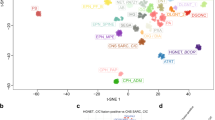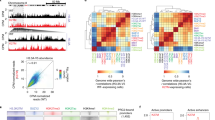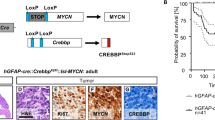Abstract
Embryonal tumors with multilayered rosettes (ETMRs) are rare, deadly pediatric brain tumors characterized by high-level amplification of the microRNA cluster C19MC1,2. We performed integrated genetic and epigenetic analyses of 12 ETMR samples and identified, in all cases, C19MC fusions to TTYH1 driving expression of the microRNAs. ETMR tumors, cell lines and xenografts showed a specific DNA methylation pattern distinct from those of other tumors and normal tissues. We detected extreme overexpression of a previously uncharacterized isoform of DNMT3B originating at an alternative promoter3 that is active only in the first weeks of neural tube development. Transcriptional and immunohistochemical analyses suggest that C19MC-dependent DNMT3B deregulation is mediated by RBL2, a known repressor of DNMT3B4,5. Transfection with individual C19MC microRNAs resulted in DNMT3B upregulation and RBL2 downregulation in cultured cells. Our data suggest a potential oncogenic re-engagement of an early developmental program in ETMR via epigenetic alteration mediated by an embryonic, brain-specific DNMT3B isoform.
This is a preview of subscription content, access via your institution
Access options
Subscribe to this journal
Receive 12 print issues and online access
$209.00 per year
only $17.42 per issue
Buy this article
- Purchase on Springer Link
- Instant access to full article PDF
Prices may be subject to local taxes which are calculated during checkout



Similar content being viewed by others
References
Li, M. et al. Frequent amplification of a chr19q13.41 microRNA polycistron in aggressive primitive neuroectodermal brain tumors. Cancer Cell 16, 533–546 (2009).
Pfister, S. et al. Novel genomic amplification targeting the microRNA cluster at 19q13.42 in a pediatric embryonal tumor with abundant neuropil and true rosettes. Acta Neuropathol. 117, 457–464 (2009).
Yanagisawa, Y., Ito, E., Yuasa, Y. & Maruyama, K. The human DNA methyltransferases DNMT3A and DNMT3B have two types of promoters with different CpG contents. Biochim. Biophys. Acta 1577, 457–465 (2002).
Benetti, R. et al. A mammalian microRNA cluster controls DNA methylation and telomere recombination via Rbl2-dependent regulation of DNA methyltransferases. Nat. Struct. Mol. Biol. 15, 268–279 (2008).
Sinkkonen, L. et al. MicroRNAs control de novo DNA methylation through regulation of transcriptional repressors in mouse embryonic stem cells. Nat. Struct. Mol. Biol. 15, 259–267 (2008).
Korshunov, A. et al. Focal genomic amplification at 19q13.42 comprises a powerful diagnostic marker for embryonal tumors with ependymoblastic rosettes. Acta Neuropathol. 120, 253–260 (2010).
Gessi, M. et al. Embryonal tumors with abundant neuropil and true rosettes: a distinctive CNS primitive neuroectodermal tumor. Am. J. Surg. Pathol. 33, 211–217 (2009).
Korshunov, A. et al. LIN28A immunoreactivity is a potent diagnostic marker of embryonal tumor with multilayered rosettes (ETMR). Acta Neuropathol. 124, 875–881 (2012).
Picard, D. et al. Markers of survival and metastatic potential in childhood CNS primitive neuro-ectodermal brain tumours: an integrative genomic analysis. Lancet Oncol. 13, 838–848 (2012).
Bentwich, I. et al. Identification of hundreds of conserved and nonconserved human microRNAs. Nat. Genet. 37, 766–770 (2005).
Suzuki, M. & Mizuno, A. A novel human Cl− channel family related to Drosophila flightless locus. J. Biol. Chem. 279, 22461–22468 (2004).
Rosenbloom, K.R. et al. ENCODE data in the UCSC Genome Browser: year 5 update. Nucleic Acids Res. 41, D56–D63 (2013).
Meacham, F. et al. Identification and correction of systematic error in high-throughput sequence data. BMC Bioinformatics 12, 451 (2011).
Bernstein, B.E. et al. The NIH Roadmap Epigenomics Mapping Consortium. Nat. Biotechnol. 28, 1045–1048 (2010).
Jin, B. et al. DNA methyltransferase 3B (DNMT3B) mutations in ICF syndrome lead to altered epigenetic modifications and aberrant expression of genes regulating development, neurogenesis and immune function. Hum. Mol. Genet. 17, 690–709 (2008).
Watanabe, D., Uchiyama, K. & Hanaoka, K. Transition of mouse de novo methyltransferases expression from Dnmt3b to Dnmt3a during neural progenitor cell development. Neuroscience 142, 727–737 (2006).
Hayette, S. et al. High DNA methyltransferase DNMT3B levels: a poor prognostic marker in acute myeloid leukemia. PLoS ONE 7, e51527 (2012).
Okano, M., Bell, D.W., Haber, D.A. & Li, E. DNA methyltransferases Dnmt3a and Dnmt3b are essential for de novo methylation and mammalian development. Cell 99, 247–257 (1999).
Tan, M.H. et al. An Oct4-Sall4-Nanog network controls developmental progression in the pre-implantation mouse embryo. Mol. Syst. Biol. 9, 632 (2013).
Morales-Prieto, D.M., Ospina-Prieto, S., Chaiwangyen, W., Schoenleben, M. & Markert, U.R. Pregnancy-associated miRNA-clusters. J. Reprod. Immunol. 97, 51–61 (2013).
Vaira, V. et al. The microRNA cluster C19MC is deregulated in parathyroid tumours. J. Mol. Endocrinol. 49, 115–124 (2012).
Flor, I. & Bullerdiek, J. The dark side of a success story: microRNAs of the C19MC cluster in human tumours. J. Pathol. 227, 270–274 (2012).
Fornari, F. et al. In hepatocellular carcinoma miR-519d is up-regulated by p53 and DNA hypomethylation and targets CDKN1A/p21, PTEN, AKT3 and TIMP2. J. Pathol. 227, 275–285 (2012).
Rhee, I. et al. DNMT1 and DNMT3b cooperate to silence genes in human cancer cells. Nature 416, 552–556 (2002).
Oka, M. et al. De novo DNA methyltransferases Dnmt3a and Dnmt3b primarily mediate the cytotoxic effect of 5-aza-2′-deoxycytidine. Oncogene 24, 3091–3099 (2005).
Ostler, K.R. et al. Cancer cells express aberrant DNMT3B transcripts encoding truncated proteins. Oncogene 26, 5553–5563 (2007).
You, J.S. & Jones, P.A. Cancer genetics and epigenetics: two sides of the same coin? Cancer Cell 22, 9–20 (2012).
Martins-Taylor, K., Schroeder, D.I., LaSalle, J.M., Lalande, M. & Xu, R.H. Role of DNMT3B in the regulation of early neural and neural crest specifiers. Epigenetics 7, 71–82 (2012).
Schwartzentruber, J. et al. Driver mutations in histone H3.3 and chromatin remodelling genes in paediatric glioblastoma. Nature 482, 226–231 (2012).
Shi, Y. & Majewski, J. FishingCNV: a graphical software package for detecting rare copy number variations in exome-sequencing data. Bioinformatics 29, 1461–1462 (2013).
Olshen, A.B., Venkatraman, E.S., Lucito, R. & Wigler, M. Circular binary segmentation for the analysis of array-based DNA copy number data. Biostatistics 5, 557–572 (2004).
Lohse, M. et al. RobiNA: a user-friendly, integrated software solution for RNA-Seq-based transcriptomics. Nucleic Acids Res. 40, W622–W627 (2012).
Trapnell, C., Pachter, L. & Salzberg, S.L. TopHat: discovering splice junctions with RNA-Seq. Bioinformatics 25, 1105–1111 (2009).
Langmead, B., Trapnell, C., Pop, M. & Salzberg, S.L. Ultrafast and memory-efficient alignment of short DNA sequences to the human genome. Genome Biol. 10, R25 (2009).
Thorvaldsdóttir, H., Robinson, J.T. & Mesirov, J.P. Integrative Genomics Viewer (IGV): high-performance genomics data visualization and exploration. Brief. Bioinform. 14, 178–192 (2013).
Li, H. et al. The Sequence Alignment/Map format and SAMtools. Bioinformatics 25, 2078–2079 (2009).
Quinlan, A.R. & Hall, I.M. BEDTools: a flexible suite of utilities for comparing genomic features. Bioinformatics 26, 841–842 (2010).
Dobin, A. et al. STAR: ultrafast universal RNA-seq aligner. Bioinformatics 29, 15–21 (2013).
Kent, W.J. BLAT—the BLAST-Like Alignment Tool. Genome Res. 12, 656–664 (2002).
Untergasser, A. et al. Primer3Plus, an enhanced web interface to Primer3. Nucleic Acids Res. 35, W71–W74 (2007).
1000 Genomes Project Consortium. A map of human genome variation from population-scale sequencing. Nature 467, 1061–1073 (2010).
Huang, W., Sherman, B.T. & Lempicki, R.A. Systematic and integrative analysis of large gene lists using DAVID bioinformatics resources. Nat. Protoc. 4, 44–57 (2009).
Maksimovic, J., Gordon, L. & Oshlack, A. SWAN: subset-quantile within array normalization for Illumina Infinium HumanMethylation450 BeadChips. Genome Biol. 13, R44 (2012).
Acknowledgements
This work was supported by the Cancer Research Society and was funded in part by Hungarian Scientific Research Fund (OTKA) contract T-04639, by National Research and Development Fund (NKFP) contracts 1A/002/2004 (P.H., M. Garami and L.B.) and TÁMOP-4.2.2A-11/1/KONV-2012-0025 (A.K. and L.B.), and by Canadian Institutes of Health Research grant 102684 (A.H.). N.J. is a member of the Penny Cole laboratory and is the recipient of a Chercheur Clinicien Senior Award. S.B. is supported by an RMGA (Reseau Médical de Génétique Apliquée; Network of Applied Genetic Medicine) fellowship. T.P. and J.M. hold Canada Research Chairs (tier 2). C.L.K. is the recipient of a fellowship award from the Fonds de Recherche du Québec-Santé, N.G. is the recipient of a studentship award from Cedars, and A.M.F. is the recipient of a studentship from the Canadian Institutes of Health Research and the McGill–Canadian Institutes of Health Research Training Program in Systems Biology. R.S. is supported by the Canadian Institutes of Health Research.
Author information
Authors and Affiliations
Contributions
N.G., D.-A.K.Q., A.P., P.S.-C., V.A., S.B., A.M.F., Z.D., C.P., T.S., D.F. and P.M.S. performed experimental work. C.L.K., M.C., H.D., S.B., S.P.-C., A.B., A.M. and J.S. performed bioinformatic analyses. C.L.K., N.G., Z.D., A.H., P.S.-C., T.D., S.P.-C., T.P., S.B., V.A., A.S., P.B., R.S., J.M. and N.J. performed data analyses and generated the text and figures. C.L.K., S.P.-C., P.H., A.K., M. Garami, M.Z., M.R., M. Gallo, P.D., M.D.T., P.P.L., L.B., J.-L.M., J.A.C., K.Z., S.A., A.F. and N.J. collected data and provided patient materials. J.M. and N.J. provided leadership for the project. All authors contributed to the final manuscript.
Corresponding authors
Ethics declarations
Competing interests
The authors declare no competing financial interests.
Supplementary information
Supplementary Text and Figures
Supplementary Figures 1–16 and Supplementary Tables 1–7 (PDF 3736 kb)
Supplementary Table 8
Differential expression analysis for all UCSC genes expressed above a minimum cutoff level (XLSX 4406 kb)
Source data
Rights and permissions
About this article
Cite this article
Kleinman, C., Gerges, N., Papillon-Cavanagh, S. et al. Fusion of TTYH1 with the C19MC microRNA cluster drives expression of a brain-specific DNMT3B isoform in the embryonal brain tumor ETMR. Nat Genet 46, 39–44 (2014). https://doi.org/10.1038/ng.2849
Received:
Accepted:
Published:
Issue Date:
DOI: https://doi.org/10.1038/ng.2849
This article is cited by
-
DNA methylation alterations across time and space in paediatric brain tumours
Acta Neuropathologica Communications (2022)
-
TTYH family members form tetrameric complexes at the cell membrane
Communications Biology (2022)
-
Overexpression of Lin28A in neural progenitor cells in vivo does not lead to brain tumor formation but results in reduced spine density
Acta Neuropathologica Communications (2021)
-
Mutant p53s and chromosome 19 microRNA cluster overexpression regulate cancer testis antigen expression and cellular transformation in hepatocellular carcinoma
Scientific Reports (2021)
-
Cryo-EM structures of the TTYH family reveal a novel architecture for lipid interactions
Nature Communications (2021)



